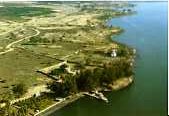
By Jurek Schulz
No other city, besides Jerusalem, is so often mentioned in the New Testament as Capernaum.
Sixteen times, the fishing village on the north-western shore of the Sea of Galilee, which was probably built in Persian times (5th Century BC), there before. It was the second home of Jesus and not just an occasional stopover (Mk 2: 1; Mt 4: 12-17). In Matthew 9: 1 we read that Jesus came to „his“ city. Historical sources prove that citizenship could only be acquired after a 12-month stay. So it can be assumed that Jesus actually possessed this, if he so designated her.
 As the city lay on the border between the territory of Philip and Herod Antipas, they had a customs post at which the later Apostle Matthew was working as an official (Mt. 9.9, Mark 2:14). But also a Roman troop department was stationed there. According to Luke 7.5, their captain in Capernaum had a synagogue built for the Jewish population.
As the city lay on the border between the territory of Philip and Herod Antipas, they had a customs post at which the later Apostle Matthew was working as an official (Mt. 9.9, Mark 2:14). But also a Roman troop department was stationed there. According to Luke 7.5, their captain in Capernaum had a synagogue built for the Jewish population.
The Gospels report on a fascinating multitude of miracles that Jesus performed in this place: He healed a paralytic (Mark 2: 3ff.), A possessed person (Mark 1:21 ff.), And Peter’s mother-in-law (Mark 1, 29ff.), Just to name a few examples. But he also gave the great talk of the bread of life in the synagogue of Capernaum (John 6: 22ff.). Thus, Isaiah 8:23, that the „Galilee of the Gentiles“ would not remain obscure, for the whole Galilean space was illuminated by the light of Jesus.
Oppressive
A visit to the ruins of Capernaum is, whenever possible, an integral part of my Israeli holidays. The impressive remains of the former synagogue still testify to the extraordinary importance of this city. At the same time, it is depressing to read in this place the prophetic word of Jesus in Matthew 11:20 ff.: The announcement of the judgment for this city because of its unbelief, precisely because many miracles occurred there. In fact, the city was destroyed by an earthquake in 746. Not long after, near the original village, a village of the same name was built, which was probably built in the
11th century was abandoned for unknown reasons. After that, the Biblical Capernaum was no longer localizable until modern times.
In 1894, the Franciscan Order was able to acquire a large ruin field on which „Capernaum“ was identified. The archaeologist Orfali between 1911 and 1921, the remains of a synagogue from the 4th century AD together. It was 24 meters long and 18 meters wide. Unlike today, it was built in a south-north direction and rich in sculptures and reliefs, such as the seven-branched candlesticks, the Star of David or the Ark of the Covenant on a wagon.
But then in 1980, the sensational news went to the archaeological world. The New Testament synagogue of Jesus had been found, directly under the limestone synagogue. What happened? It is commonly believed that almost all the limestone synagogues in Galilee come from the reign of Theodosius I (397-395 AD). However, the synagogues of Galilee from the time of Jesus were generally basalt stone synagogues. After the destruction of Jerusalem and the whole country by the Romans (66-70 AD), it was customary in the Jewish tradition to build a new synagogue on the foundation of an earlier one. So it is archaeologically assured that the basalt foundations of the limestone synagogue actually come from the time of Jesus. (The different stone types are clearly recognizable on our cover picture.)
encouraged
Amazement triggered scriptural texts in the mortar of the „Peter’s House“, an exposed house: prayers and invocations of the name of Jesus, also the name of Peter came before – hence the name of the building. Likewise, Jewish and Christian symbols were found throughout the houses. The Benedictine archaeologist Bargil Pixner found a remarkable explanation for this: in Capernaum there was a symbiosis of rabbinic and Jewish believers visiting the same synagogue. In addition, the „Petrus House“ served as a meeting place for communion celebrations.
How did Pixner come to this conclusion? In the 4th century AD, no Gentiles were allowed to settle in Capernaum. Nevertheless, rabbinic sources confirm that at that time, the faithful of Jesus lived in Capernaum. So it seems reasonable to assume that these were Jews who believed in Jesus and upheld the memory of Jesus‘ work by participating in the construction of this synagogue and a prayer room above the Petrus House.
„Capernaum“ in Hebrew means „Kfar Nachum“, which means „village of Nahum“. Whether this means the Prophet Nahum, we no longer know today. Be that as it may, this place reminds me regularly of the wonderful promise in Nahum 1: 7, „The Lord is kind and a stronghold at the time of need. He knows those who trust in him. „
Picture and text: Amzi